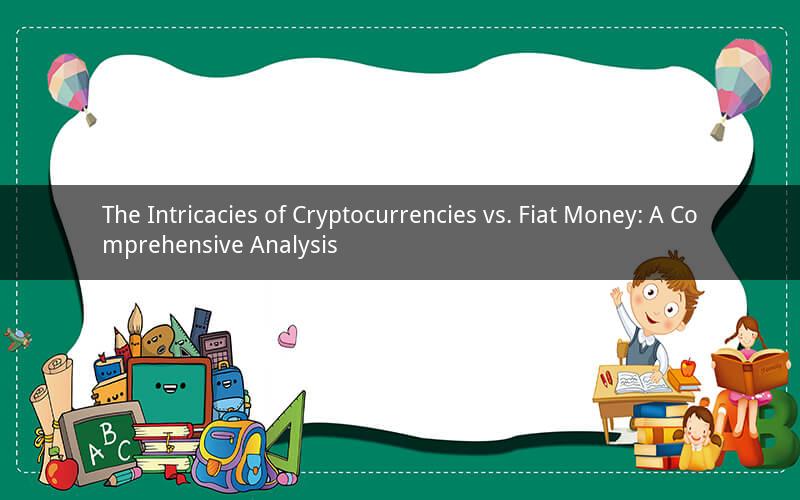
In the rapidly evolving landscape of finance, cryptocurrencies and fiat money stand as two distinct paradigms. Cryptocurrencies, such as Bitcoin and Ethereum, operate independently of any central authority, while fiat money, like the US dollar and the Euro, is issued and regulated by governments. This article delves into the nuances of these two systems, exploring their origins, functions, and implications for the future of money.
Origins and History
Cryptocurrencies emerged in the wake of the 2008 financial crisis, which highlighted the vulnerabilities of traditional banking systems. Bitcoin, the first and most well-known cryptocurrency, was introduced in 2009 by an anonymous entity or group known as Satoshi Nakamoto. It was designed to be a decentralized digital currency, free from the control of any central authority.
Fiat money, on the other hand, has a long history that dates back to ancient civilizations. The concept of fiat money, which is money that has value by government decree, became more prevalent during the Renaissance. Today, most of the world's currencies are fiat, with the US dollar being the most widely used.
Functions and Uses
Cryptocurrencies and fiat money serve different purposes in the economy. Cryptocurrencies are primarily used as a medium of exchange, a store of value, and a unit of account. They offer several advantages, such as lower transaction fees, faster processing times, and increased privacy.
Fiat money, on the other hand, is primarily used as a medium of exchange and a store of value. It is also used as a unit of account, with prices and wages typically expressed in fiat currency. The main advantage of fiat money is its widespread acceptance and the trust it inspires among its users.
Regulation and Security
One of the key differences between cryptocurrencies and fiat money is the level of regulation. Cryptocurrencies operate in a relatively unregulated environment, which has led to concerns about security and consumer protection. While some countries have started to regulate cryptocurrencies, the industry remains largely decentralized.
Fiat money, on the other hand, is subject to strict regulation by governments and central banks. This regulation ensures the stability and reliability of the currency, but it also limits the freedom of individuals and businesses to use it as they see fit.
Market Volatility
Another significant difference between cryptocurrencies and fiat money is their market volatility. Cryptocurrencies are known for their extreme price fluctuations, which can be attributed to factors such as limited supply, speculative trading, and regulatory news.
Fiat money, while not immune to volatility, tends to be more stable due to the backing of a government and the central bank's ability to control the money supply. This stability makes fiat money a more reliable option for long-term savings and investments.
Innovation and Future Potential
Cryptocurrencies and fiat money both have the potential to drive innovation in the financial sector. Cryptocurrencies offer a decentralized, transparent, and secure alternative to traditional banking systems, which could lead to more inclusive financial services and lower costs.
Fiat money, on the other hand, is constantly evolving to adapt to the changing needs of the economy. Central banks are exploring digital currencies, such as the digital euro and the digital dollar, which could offer the benefits of cryptocurrencies while maintaining the stability and trust of fiat money.
Conclusion
In conclusion, cryptocurrencies and fiat money represent two distinct approaches to money and finance. While cryptocurrencies offer innovation and potential for a more inclusive financial system, fiat money remains the dominant currency due to its stability and widespread acceptance.
Are cryptocurrencies a threat to fiat money, or can they coexist peacefully?
How do the regulatory frameworks for cryptocurrencies and fiat money differ, and what are the implications for users?
What are the potential benefits and drawbacks of using cryptocurrencies as a medium of exchange?
How does the market volatility of cryptocurrencies compare to that of fiat money, and what does this mean for investors?
What role can cryptocurrencies and fiat money play in the future of the global economy?
1. Are cryptocurrencies a threat to fiat money, or can they coexist peacefully?
Cryptocurrencies and fiat money can coexist peacefully, as they serve different purposes and cater to different needs. While cryptocurrencies offer innovation and potential for a more inclusive financial system, fiat money remains the dominant currency due to its stability and widespread acceptance.
2. How do the regulatory frameworks for cryptocurrencies and fiat money differ, and what are the implications for users?
The regulatory frameworks for cryptocurrencies and fiat money differ significantly. Cryptocurrencies operate in a relatively unregulated environment, which can lead to concerns about security and consumer protection. In contrast, fiat money is subject to strict regulation by governments and central banks, ensuring stability and reliability.
3. What are the potential benefits and drawbacks of using cryptocurrencies as a medium of exchange?
The potential benefits of using cryptocurrencies as a medium of exchange include lower transaction fees, faster processing times, and increased privacy. However, the drawbacks include market volatility, regulatory uncertainty, and security concerns.
4. How does the market volatility of cryptocurrencies compare to that of fiat money, and what does this mean for investors?
Cryptocurrencies are known for their extreme price fluctuations, which can be attributed to factors such as limited supply, speculative trading, and regulatory news. In contrast, fiat money tends to be more stable due to the backing of a government and the central bank's ability to control the money supply. This means that cryptocurrencies may be riskier for investors looking for long-term stability.
5. What role can cryptocurrencies and fiat money play in the future of the global economy?
Cryptocurrencies and fiat money can play complementary roles in the future of the global economy. Cryptocurrencies have the potential to drive innovation and offer a more inclusive financial system, while fiat money remains the dominant currency due to its stability and widespread acceptance. The key will be finding a balance between the two systems to maximize their benefits while minimizing their drawbacks.